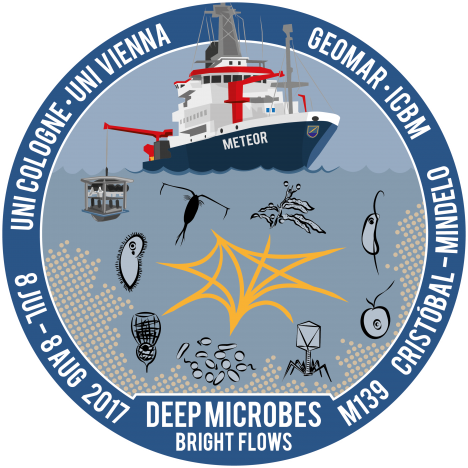
*see German version below
“DEEP MICROBES” is the title of the research cruise M139 headed by Prof. Dr. Hartmut Arndt at the University of Cologne (Germany) in collaboration with the University of Vienna (Austria), the GEOMAR in Kiel (Germany) and the ICBM at the University of Oldenburg (Germany). Our expedition will take us across the Atlantic Ocean from Cristóbal (Panama) to Mindelo (Cape Verde). This blog is to inform you about the latest news on board at the FS Meteor. Stay in contact with us and feel free to share all contents.
Almost two-thirds of the biosphere of the Earth is deep sea with 98 % of its volume below 2,000 m depth. It is the least explored ecosystem of the Earth and is populated by many undiscovered species. The life in the deep sea is dominated by marine microbes which are true master regulators of the global carbon flux for the last 3.5 billion years. Yet the roles of prokaryotes (bacteria and archaea) and eukaryotes (protists) remain unclear. How many of them are out there, and how many types? What are their functions? How do they adapt to changes in environmental conditions and how will they respond to them in the future?
Our team of biologists will investigate the vertical distribution of marine microbial biodiversity using a novel sampling method by sampling multiple deep-sea basins of the Atlantic Ocean from the ocean surface down to 5,000 m depth including the marine sediment. In addition, we will perform novel experiments to explore the interactions between marine protists, bacteria and viruses in the deep sea.
“BRIGHT FLOWS” is the second mainstay of M139 and deals with volcanism on the maturing ocean plate. The geology of the deep seafloor is virtually unknown and basic knowledge of bathymetry is missing in most areas. Multibeam bathymetric mapping combined with co-registered acoustic backscatter intensities can change this situation. During the transit from Barbados to the Mid-Atlantic Ridge (M127, May 2016), an area of high acoustic reflectivity on 20 million years old seafloor was investigated that is linked to the presence of several small cones, implying the presence of lava flows. Two more research cruises crossing this area confirmed our findings. Further calculations suggest that these lava flows have a maximum sediment cover of 2 m (possibly less depending on the surface morphology and hence sonar reflectivity of the lava flows). The sediment accumulation rates (about 1 cm per 1000 years) led to 200 m of sediment in this area, but the thin sediment covering of the lava implies that the eruption occurred less than 500,000 years ago.
Our team of geoscientists will investigate the nature of the high backscatter signals, make visual observations and rock sampling of the pretended lava flows to determine their age and composition, and map out their full areal extent to estimate the magma volumes erupted.
–
„DEEP MICROBES“ ist der Titel der Forschungsexpedition M139 geleitet von Prof. Dr. Hartmut Arndt von der Universität zu Köln in Zusammenarbeit mit der Universität Wien, dem GEOMAR in Kiel und dem ICBM der Universität Oldenburg. Unsere Expedition wird uns über den Atlantischen Ozean von Cristóbal (Panama) bis nach Mindelo (Kap Verde) führen. Dieser Blog informiert Sie über die Neuigkeiten an Bord der FS Meteor. Bleiben Sie mit uns in Kontakt und teilen Sie gerne alle Inhalte.
Fast zwei Drittel der Biosphäre der Erde bestehen aus Tiefsee mit 98 % ihres Volumens unterhalb von 2000 m Tiefe. Sie ist das am wenigsten erforschte Ökosystem der Erde und ist von vielen unentdeckten Arten bevölkert. Das Leben in der Tiefsee wird von marinen Mikroben dominiert, die seit 3,5 Milliarden Jahren die Hauptregulatoren der globalen Kohlenstoffflüsse sind. Dennoch ist die Rolle der Prokaryoten (Bakterien und Archaeen) und Eukaryoten (Protisten) immer noch unklar. Wie viele von ihnen gibt es da draußen, und wie viele Typen? Was sind ihre Funktionen? Wie adaptieren sie sich an Veränderungen von Umweltbedingungen und wie reagieren sie darauf in der Zukunft?
Unser Team von Biologen wird die vertikale Verteilung von mariner, mikrobieller Biodiversität erforschen, indem mithilfe einer neuen Beprobungsmethode mehrere Meeresbecken des Atlantischen Ozeans von der Wasseroberfläche bis zu 5000 m Tiefe inklusive dem marinen Sediment beprobt werden. Darüber hinaus werden wir neuartige Experimente durchführen, um die Interaktionen zwischen marinen Protisten, Bakterien und Viren in der Tiefsee zu untersuchen.
„BRIGHT FLOWS“ ist das zweite Standbein von M139 und beschäftigt sich mit Vulkanismus auf alter ozeanischer Kruste. Die Geologie der tiefen Ozeanbecken ist praktisch unbekannt und viele grundlegende Kenntnisse der Meeresbodenbeschaffenheit fehlen. Moderne Fächerecholote können diese Situation ändern und geben neben hochaufgelösten Tiefeninformationen auch Daten zur Meeresbodenbeschaffenheit (basierend auf akustischen Rückstreuungseigenschaften). Während des Transits von Barbados zum Mittelatlantischen Rücken (M127, Mai 2016) wurden Flecken mit ungewöhnlich hohen Intensitäten von akustischer Rückstreuung auf etwa 20 Millionen Jahre alte Kruste gemessen. Diese Flecken sind mit mehreren Kegeln am Meeresboden assoziiert, was auf Lavaflüsse und kleinere Vulkane hindeutet. Zwei weitere Forschungsexpeditionen über dieses Areal konnten diese Daten bestätigen. Weitere Berechnungen lassen vermuten, dass die Lavaflächen mit höchstens 2 m Sediment bedeckt sind (vermutlich weniger, abhängig von der Oberflächenmorphologie und damit der Sonar-Reflektivität der Lavaflüsse). Die Rate an Sedimentakkumulation in diesem Gebiet (etwa 1 cm pro 1000 Jahre) führte zu etwa 200 m mächtigen Sedimenten und die nur dünn sedimentierten Lavaflächen weisen auf ein sehr junges Alter der Eruption vor weniger als 500.000 Jahren hin.
Unser Team von Geowissenschaftlern sucht die visuelle Bestätigung, dass es sich tatsächlich um Lavafelder handelt. Wir werden die Ausdehnung der Lavaflächen mit dem Tiefseeecholot kartieren und Gesteinsproben vom Meeresgrund bergen, um das Alter, die Zusammensetzung und damit die Herkunft dieser neuen Art des Ozeanbodenvulkanismus zu untersuchen.
This expedition is being financed by the German Research Foundation. / Diese Expedition wird von der Deutschen Forschungsgemeinschaft gefördert.
Illustration (Logo): Timo Schwittay
Contact/Kontakt:
Chief Scientist/Fahrtleiter
Prof. Dr. Hartmut Arndt
University of Cologne
Biocenter
Institute for Zoology
General Ecology
Zülpicher Str. 47b
D-50674 Köln
Germany
Phone: +49 221 470-3100 or – 5666
Mail: hartmut.arndt(at)uni-koeln.de